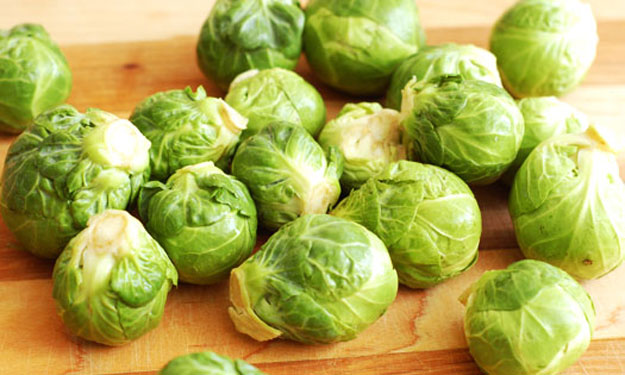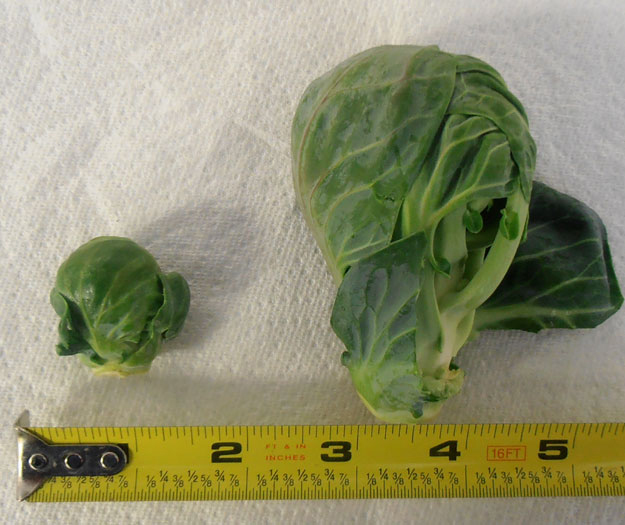Not that Brussels Sprouts is a commodity that garners much inspection attention, you still should always look for various defects that may affect them. Future posts will include some of the more common defects, such as yellow and discolored leaves, insect damage and decay.
If you pull out the U. S. Grade Standards for Brussels Sprouts I guess you could jokingly say the USDA got it right about 60 years ago. Amazing as this may sound, the current U.S. Grade Standard was created in 1954. Maybe now that the fresh market for brussels sprouts is expanding, cutting into the frozen market, the USDA may find some time to update the standard.
As you receive some brussels sprouts there are some basic inspection procedures you must follow.

When you spread them out, to inspect, a few questions may come to mind.
- The tolerances are based on a weight basis, how do I weigh them?
- How many do I weigh for a sample?
First off, let’s clear some things up from 1954. In the U.S. Grade Standard for Brussels Sprouts you will find the following; “In order to allow for variations incident to proper grading and handling, other than for size, not more than a total of 10 percent, by weight, of the Brussels sprouts in any lot may fail to meet the requirements of the grade.”
But if you look further into the same standard it states; “§51.2254 Basis for calculating percentages. Percentages shall be calculated on the basis of weight or an equivalent basis.” The key words being, “Equivalent Basis”……which leads to the next question, what does that mean?
You won’t find the answer in the grade standard. But, if you happen to be one of the few that have access to the USDA’s Inspection Instruction Handbook for Brussels Sprouts, you will have the answer to your question……sort of. The USDA’s instructions are a bit confusing. In one paragraph the USDA instructs their inspectors to weigh out their sample, with 48-50 ounces being a sufficient sample. In the very next paragraph the USDA instructs their inspectors to count out their sample, with 100 sprouts being an adequate sample size, as long as the sprouts are fairly uniform in size.

Are these sprouts fairly uniform in size? The USDA tells us that the definition of fairly uniform is if the smallest sprout and the largest sprout in your sample do not vary by more than 3/8 inch in diameter. If they are outside this range, as shown above, base the inspection on weight. If they are indeed fairly uniform in size then it is permissible to base your inspection on count.
So how does this play out in the real world? Do inspectors really measure the sprouts to see if they are within this 3/8 range? Of course not. Just think how confusing it would be if the sprouts in the first sample were fairly uniform, so you base the inspection on count, but the second inspection had sprouts not being fairly uniform, thus inspecting the second sample on a weight basis, and the third was fairly uniform again, so you are back to counting out your sample, etc. Experienced inspectors will immediately count out 100 sprouts and base their inspection on count, for every sample, never pulling their scale (or tape measure) out of their inspection equipment bag. They have seen how ridiculous this procedure is.

3 Comments on “Brussels Sprouts- Inspection Procedures”
i agree with you that the measuring procedure is ridiculous and should be omitted. however i do not agree with teaching inspectors either usda or private sector to divert immediately to count. i believe weight is a more accurate way to determine your percentages. a true inspector and also a private sector warehouse that deals with 25# bulk containers regularly should be equipped with a digital scale and few small tupperware containers to weigh different defects out quickly and efficiently. having inspectors getting in the habit of taking shortcuts is part of the problem and why there is distrust in the industry. if you have 5 small sprouts that meet minimum size of 1 inch i would find it hard to believe they would weigh more than 2 ounces. if they all had decay and you based off of 100 count you would fail the sample at 5% decay. based off of weight and assuming your weight is 2 ounces (probably less for small sprouts) the sample is still in grade at 4% decay correct? this of course is just my opinion most bulk sprouts are packed at larger diameter than 1 inch these days but inspectors should be aware of this if they encounter load that is small in size.
yo trabajo en un empaque estoy realizando un procedimiento de muestreo de producto terminado,regularmente empacamos en presentación de 25 libras, la muestradora realiza una inspeccion de toda la caja por conteo.
en mi procedimiento estoy basandome en el manual de USDA 2005 Y CODEX ALIMENTARIUS. QUISIERA MEJORAR MI PROCEDIMIENTO Y LA MANERA DE INSPECCION,AYUDA GRATIS.
Veronica, basing your sample on the entire contents may be accurate but it will be very time consuming. If I had one hour to properly inspect a lot of brussels sprouts I would rather inspect 8 to 10 different cartons, sampling only 100 sprouts per carton, than 2 to 3 cartons while inspecting the entire carton of each.